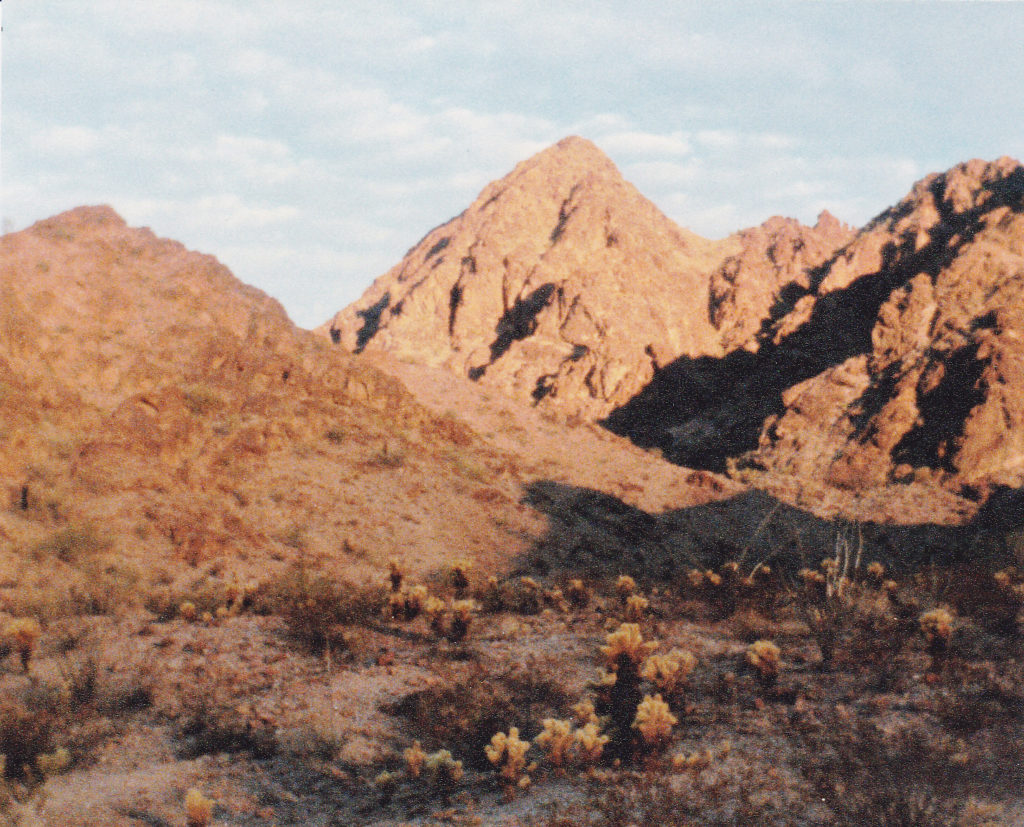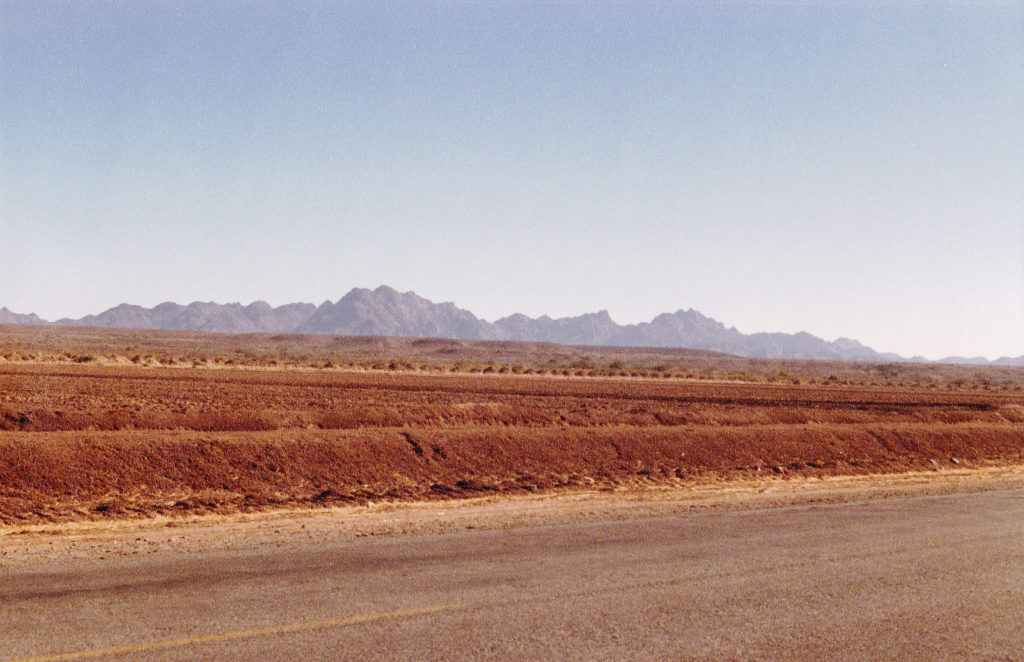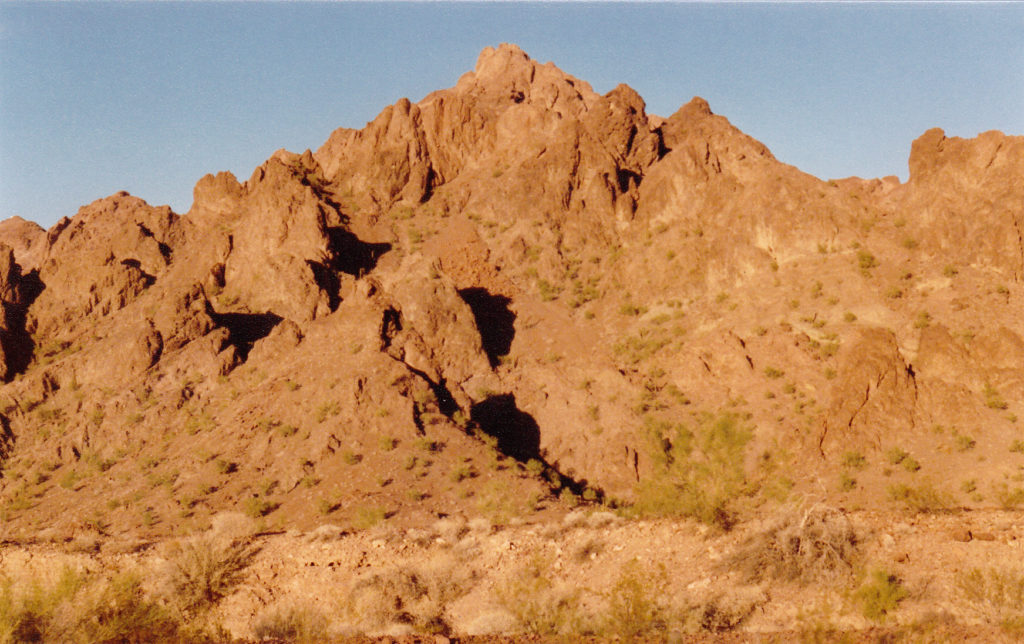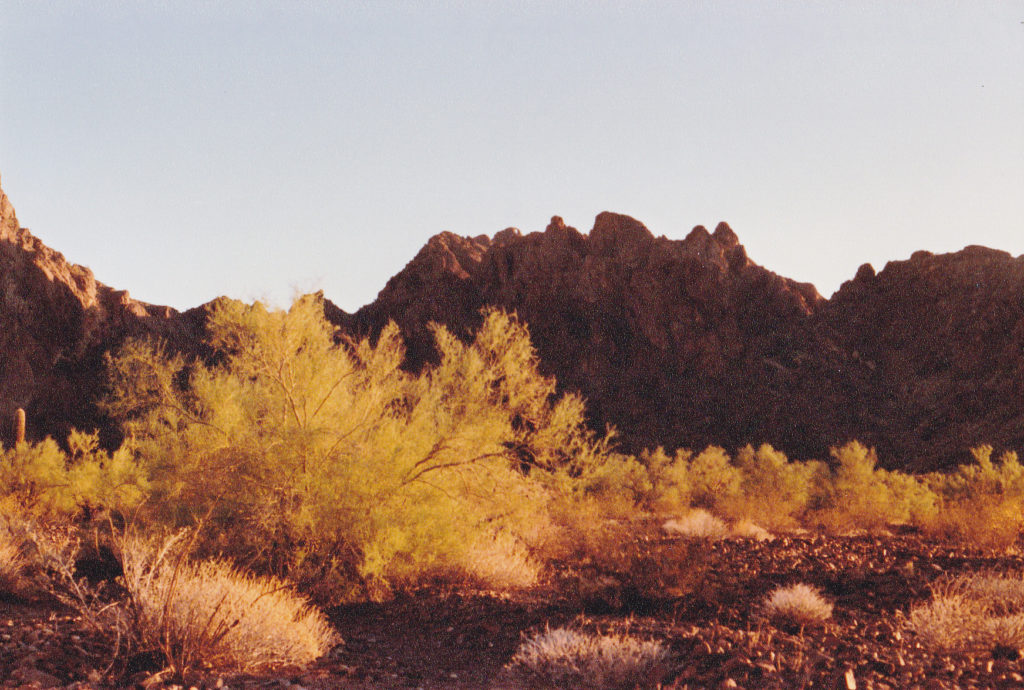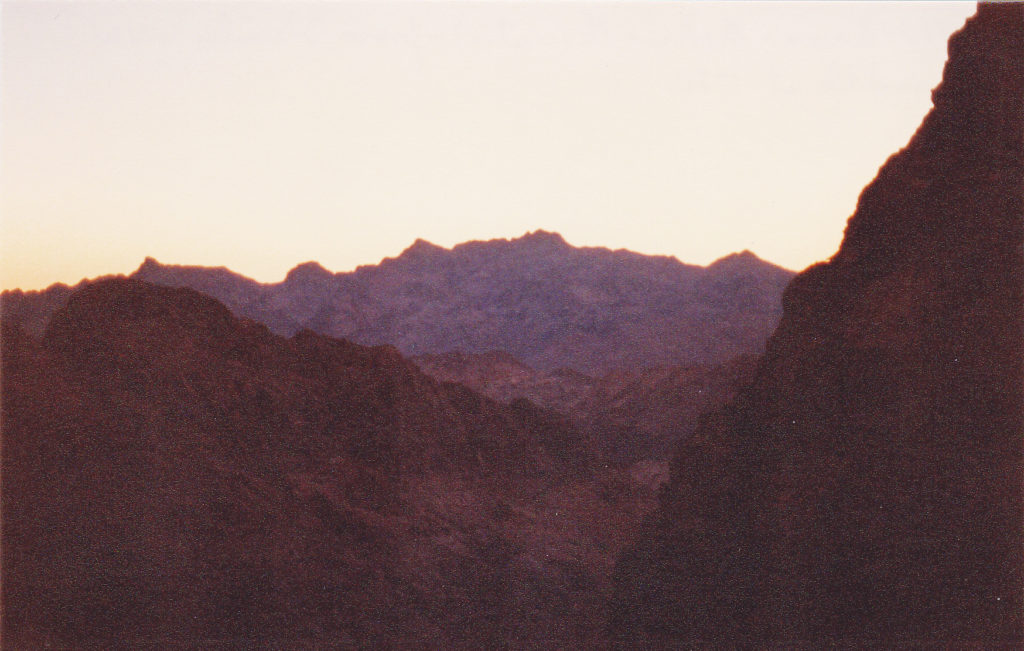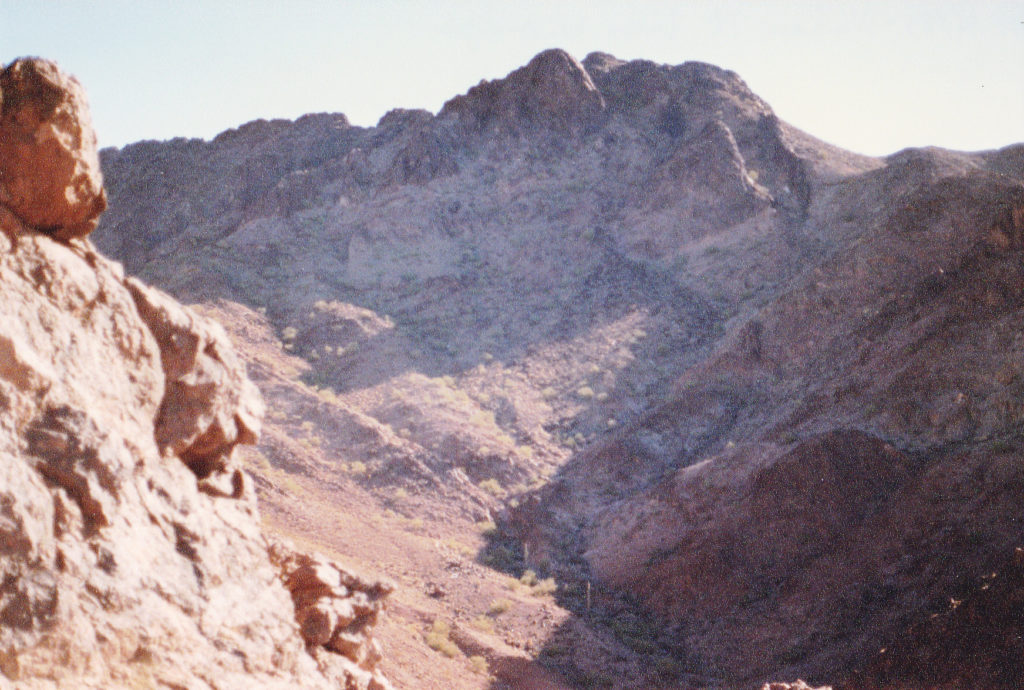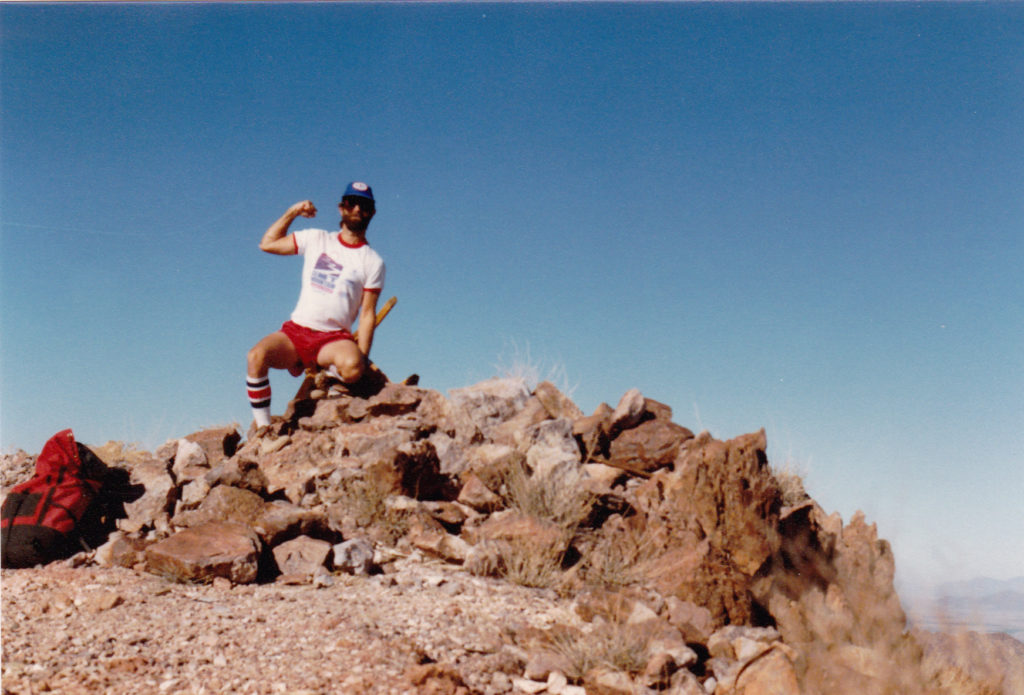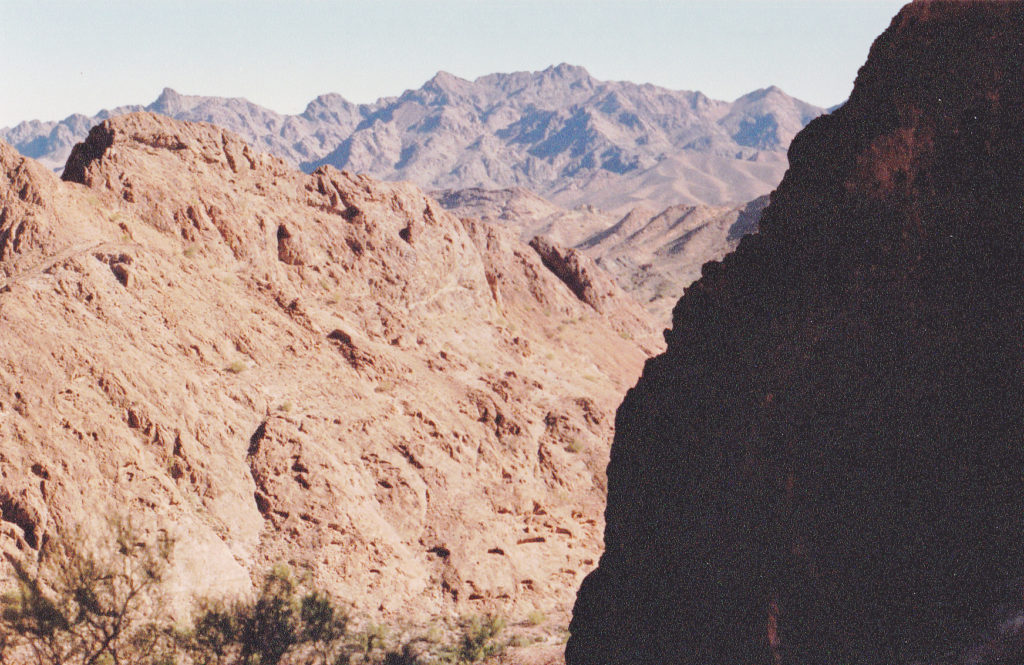Any reader of this site knows I’m all about the stealth climb. I’m proud to say I’ve been climbing in places I’m not supposed to for the last 30 years, and boy oh boy, I’m living in the best state imaginable for that kind of thing. Arizona is a mecca for stealth climbing, filled with all manner of areas where nobody is allowed to go. I got thinking the other day about memorable stealths and one came to mind, one I did 27 years ago in the Atlantis of my youth.
The Yuma Proving Ground is an area about which you’ve never heard me speak. It’s a curious place, known to few. In the far southwestern corner of Arizona, it encompasses a large area of desert used by the U.S. Army, over 1,300 square miles of shooting and blowing up stuff. There’s very little of it that the army will let you visit, and the vast majority of it is strictly off-limits, but since when does that stop determined peakbaggers?
There are several mountain-range highpoints located inside that forbidden area, so what’s a climber to do? Well, duh! The first one I’d like to tell you about is a peak called Twin Benchmark, at 2,822′ the high point of the Chocolate Mountains. This one is a little over 5 miles of pretty tame trespass into the proving ground, and a dozen souls have made their way to the summit. The peak is in a beautiful valley, a quiet place frequented by bighorn sheep and mountain lions. The night I spent there was so dark that Venus cast a shadow.
The second is a mere 13 miles south of Twin, in an obscure range called the Middle Mountains. This one is a little more exciting. The only way you can climb it is to park on the shoulder of U.S. Highway 95, in plain view of all passers-by. The proving ground flanks both sides of the highway, so if you’re parked there and not at your vehicle, it’s obvious you’ve either abandoned your car or have trespassed into the proving ground. A mere 1.4 miles west of the highway sits Los Angeles Benchmark, as plain as day. Warning signs festoon the fence, there be dragons. This one has to be done quickly, no loitering allowed. I hate running, always have, but on this day I ran, making a beeline for the peak. Military roads criss-cross that stretch of no-man’s-land, and ominous-looking army stuff dots the landscape. I tagged the summit and immediately started back. When I was most of the way back to my truck, I was crossing a major drainage called Los Angeles Wash when I heard something loud approaching. Tension clung to me like a sweat. Scrambling for the nearest cover, I cowered under a big mesquite tree as a huge helicopter gunship roared past, directly overhead. I almost soiled myself, and a minute later when I had calmed down a bit, I lit out for the highway once again. It’s one I wouldn’t repeat. Only nine fools are known to have done this one, and several have reported exciting events like mine. Not for the faint of heart.
Which brings us to the third one, the best of all. Mohave Peak is the high point of the Trigo Mountains, and back in the 1980s, after I had climbed the highest point of each of Arizona’s 193 mountain ranges, I ranked this one among my 10 favorite climbs in the state. There are about a dozen known ascenders of this peak, but probably a bunch of others have done it who will never admit it. It’s an interesting climb for several reasons, and I’ll try to paint a picture for you.
One way you could approach Mohave is to walk or bike in on a dirt road that heads west from the highway for about 16 miles, and then do another 4 miles on foot. The only problem with that is the fact that you’d be so obvious, the chance of getting caught would be pretty darn great – you’d need much bigger cohones than I possess. When planning my climb, I ruled out that route early on, and I’m not sure if anyone has actually ever tried it. Fortunately, there is another, better option.
In this area, the mighty Colorado River acts as a natural boundary between Arizona on the east and California on the west. If you drive on Interstate 40 to the small town of Ehrenberg, Arizona, then cross the river west into California to the town of Blythe (or Blight, as climber John Vitz affectionately calls it), you can drive south through an agricultural area and cross back into Arizona to end up in the Cibola Valley. Here’s a view looking southeast to the Trigo Mountains.
Finally, 22 miles after leaving the freeway, you head east up a dirt road and 4 miles later, you park at the end of the road at 1,000 feet elevation. A curious thing about this spot is that the topo map shows a dashed line representing the western edge of the Proving Ground which is labeled “Military Reservation Boundary (Indefinite)”. I’m not quite sure what that means. Is it some kind of grey area? Makes it kind of hard to know when your trespass on to Army land has begun.
When I was here in December of 1989, I arrived on a fine, blue-sky afternoon and was amazed by the rugged beauty of the remote desert valley in which I found myself. One mile to the northeast sat Peak 2562. Here it sits in the golden glow of late afternoon.
From the same parking spot, this peak could be seen to the south. It’s name is Needles Eye, elevation 2,539 feet, and Chocolate Benchmark sits on its summit (merely a coincidence, as it has no relationship to the Chocolate Mountains mentioned earlier in this piece).
I settled in for the night, but didn’t sleep well. The climb tomorrow would be one of my first big military stealths, way back before I got really good at it, and I’ve gotta admit I was concerned. Of what, exactly, I couldn’t say for sure – maybe that I’d run into a squad of army guys out there in the hinterland, all heavily armed, who’d arrest or shoot me! I set an alarm for oh-dark-thirty – my plan was to start well before daylight, by headlamp – this was the shortest day of the year, and I’d need every minute of time I could squeeze out of it.
Damn, that alarm went off awfully early! I crawled out of the sleeping bag into the chill morning air, pulled on my trousers, stepped into my boots and shouldered my pack, already prepared from the night before. It’s hard to move quickly at night when you’re dodging cactus and trying not to fall into gullies, but I did the best I could. In not much more than a mile, I had reached the head of the valley and climbed 800 vertical feet to a saddle. By now, the sun stood poised on the world’s rim, and I thought I could see my goal in the distance. It seemed a long way off, but I was excited about the route I planned to take to get there.
From the saddle, I dropped steeply down into an un-named wash, heading east. The day grew bigger and bigger. As I stayed in the valley bottom, other tributaries came in from both sides, some of them quite substantial. Of course, these feeder washes were also dry as a bone, as things nearly always are here in the desert, but they were tributaries nonetheless. I was heading steadily downhill, losing all of the elevation I had gained earlier climbing up to the saddle. Four miles after leaving camp, I reached a major drainage coming in from the right. Now, it was time to start uphill once again – I was heading south. These valleys I was in were pristine desert – unspoiled, with no piece of trash left by Bad Guys, previously trodden only by 4 climbers before me. I was in heaven, navigating by map and compass, twisting and turning from one valley up into the next. It was crucial to make correct decisions here – if you didn’t, you’d end up in some wrong valley nowhere near your objective. My path turned east, then south again. The canyon tightened up, and I climbed up on to a ridge at around 1,500 feet. I was getting close – this was the long, sinuous west ridge of Mohave Peak itself.
All I had to do now was put one foot in front of another, and after a climb of about 1,300 feet along this enjoyable ridge, I topped out on the summit of Mojave Peak, elevation 2,768 feet. It had taken 4 hours 9 minutes from camp to travel the 7.6 miles, and every minute of it was enjoyable. There was no bushwhacking to speak of, just pure desert bliss the entire way.
The view was off the charts. Mojave Peak towered over everything in the vicinity – in fact, the nearest higher peak was Twin Benchmark, 9 miles to the east in the Chocolate Mountains mentioned earlier in this piece. There was a benchmark on this summit with the appropriate name of “Trigo”. I knew of only two prior ascents, and that was by my friends from California. They had been there a few years earlier, but at the time of my visit back in 1989, I hadn’t yet met them.
As always, I looked around for a summit register, but found none. However, I did find a broken glass jar, no doubt what remained of one left by the first ascent party. There were remnants of Army stuff, and I’m sure they were the culprits who’d destroyed the register (I would see this on other summits in the Yuma Proving Ground in years to come – it appears they didn’t take kindly to climbers sneaking into their territory). I left one of my own, but I found out in later years that it too had disappeared.
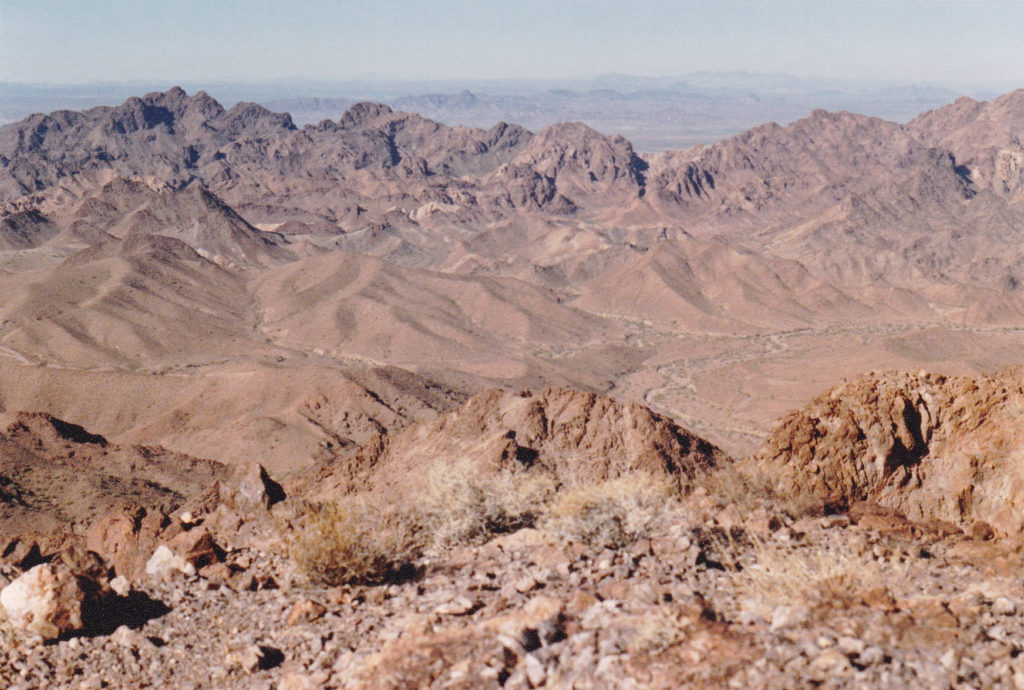
Looking west from the summit of Mohave Peak. The saddle I crossed at dawn is just to the right of center on the distant ridge.
I can’t remember how long I lingered on the summit, but it wasn’t long enough. Why is it that there’s never enough time to savor that reward? Probably for me, at least, it’s because I don’t like navigating in the dark – sure, I’ll do it when forced to, but not by choice. I always err on the side of caution, especially when I’m alone, and this was the dead of winter, the time of shortest days.
After maybe 30 minutes, I started back down, reversing my steps and getting most of the vertical out of the way. Lower down, in the canyon bottom, I could relax and enjoy the scenery and the walk out, and what a walk it was. So quiet, so peaceful – the silence was glacial and profound. The walk was an easy one – I didn’t have to pay a lot of attention to my footing in the sandy wash, so could instead focus on the beauty of the canyon walls. Hours passed, the downhill became uphill again, and I reached the saddle of early morning. My truck was visible in the distance, and each step downhill brought me closer.
When I reached it, just over 8 hours had passed and the soles of my boots had 15 miles less life on them. What a great day! As I said earlier, this turned out to be one of my favorite climbs in all the mountain ranges of Arizona. I still look back on it fondly. Also, as far as stealths go, this one is perhaps the worst-kept secret in Arizona.
Please visit our Facebook page at https://www.facebook.com/pages/Desert-Mountaineer/192730747542690

